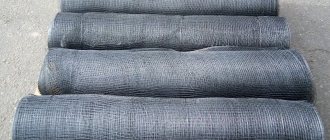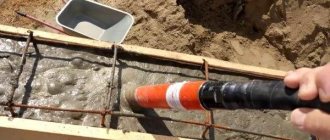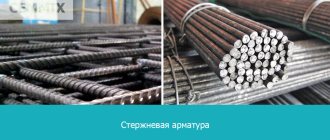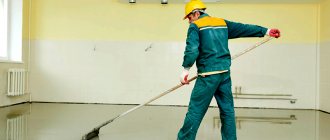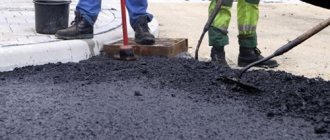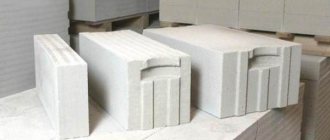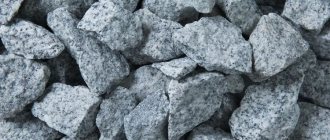It is a sheet in which metal rods are welded together perpendicularly.
The concrete mass itself is a durable building material, but the strength characteristics of steel rods are higher than those of concrete. Therefore, metal mesh can strengthen the concrete structure so that it can perform successfully under tensile and bending loads
. Also, its correct use during concreting will prevent the appearance of cracks in the concrete body under loads and temperature changes, and will also extend the service life of the entire structure many times over.
Conclusion: reinforcement is the connection of metal rods and monolithic concrete, resulting in strong load-bearing reinforced concrete structures.
Mesh Features
Reinforcement is not mandatory for floor screeds. Building codes for them establish only strength requirements. In most cases, in apartments and cottages you can do without reinforcing mesh. However, there are many situations when such reinforcement of concrete on the floor is not only recommended, but necessary for proper reliability and durability.
Advantages of reinforcement
The use of mesh for screeding is determined by the desire:
It is recommended to use nets when installing screeds on a movable wooden base or soil, when you need to strengthen the floor under a stove or fireplace and when the poured concrete layer is more than 50 mm thick. Reinforcement should also be done when laying the underlying layer of mineral wool and in the presence of expanded clay bedding. In these cases, without reinforcement, the floor concrete will sooner or later crack and fail.
Design features of reinforced screed
Types, scope of application and manufacturing specifics
Building material is used for reinforcement:
- brickwork;
- screeds of load-bearing structures;
- concrete;
- sexual screeds.
Mesh models differ in overall dimensions, cell types and rod thickness. When choosing, it is worth considering, for example, that in terms of their capabilities, fiberglass materials, with other parameters being equal, demonstrate higher efficiency than metal ones. That is, composite reinforcement KSP with a thickness of 2 mm is quite capable of replacing steel F 5 mm.
The material is formed from parallel fibers with a polymer coating. The integrity of the top layer provides the product with solidity and good adhesion. After applying the coating, special relief coils are created on the rod, giving it rigidity, adhesion, and the ability to be securely fixed when in contact with materials of different densities and consistencies.
Kinds
Floor screed mesh is sold in stores:
- steel with galvanization;
- plastic polypropylene;
- fiberglass (fiberglass);
- basalt.
In the first and second cases, meshes for floor reinforcement are made of steel or polypropylene. And the last two options are composite materials based on glass or basalt, which are supplemented with a binder plastic.
Reinforcing screed makes the floor stronger and more durable
Steel
Steel mesh should only be galvanized, otherwise its service life in the screed will be short. The main advantage of the metal version is fire resistance. All other analogues consist entirely or partially of plastics and are susceptible to high temperatures. If there is a fire on the floor, only the steel in the concrete will retain its properties.
Despite all its strength and reliability, steel reinforcing mesh is susceptible to corrosion. Even after galvanizing, it begins to rust over time. If the screed is done on the floor in a bathroom, bathhouse, shower or near a swimming pool, then it is better to choose a different material.
Advantages of steel mesh for reinforcement
Polypropylene mesh for screed
The polypropylene screed mesh is resistant to moisture and alkalis, which are characteristic of concrete mortar. It is slightly inferior in strength to steel, but weighs 6–7 times less. If the floor has to be reinforced in an old house with wooden floors, then this point is extremely important. Plus it has much better tensile strength.
Polypropylene mesh options
Another advantage of this plastic mesh is elasticity. With strong pressure from above on the screed, it stretches without breaking, and then returns to its original state. Steel and fiberglass with similar loads on the floor often simply break at the junction of the rods with each other.
Advantages of using plastic mesh
Fiberglass
Fiberglass (fiberglass) is contraindicated in high temperatures and alkalis. But it is not afraid of water and is cheap. And to withstand alkaline effects, meshes made from this material are coated with polymers during manufacturing. Without such protection, fiberglass is “eaten up” in a concrete screed within literally five years. And with it, the leveling layer of the floor lasts for 40–50 years without any problems.
Fiberglass mesh
Fiberglass is lightweight and easy to install. In terms of strength, fiberglass reinforcement is not inferior to other options. But, like all non-metallic analogues, fiberglass is superior to steel in thermal conductivity by almost two orders of magnitude. If the floor is poured onto the ground, then preference should be given to fiberglass reinforcing mesh.
Basalt
The basalt version is similar in characteristics to fiberglass. Only here in production a different supporting material is used - basalt fiber. This mesh has a bronze tint, is resistant to corrosion and can easily withstand the effects of alkalis.
Application of basalt mesh
In addition to the lack of susceptibility to rust, basalt, fiberglass and polypropylene reinforcement of floor screeds do not conduct electricity and do not shield communication signals. In this regard, it greatly outperforms its steel counterpart.
Advantages of using basalt mesh
Material cost
Reinforcing a floor screed is a fairly profitable operation. A home master can count on the following financial costs:
- for screed reinforcement - the price starts from 77 RUR/piece. (50x50 mm);
- for concrete reinforcement – the price starts from 140 RUR/piece. (100x100 mm). At approximately the same cost, mesh BP 5 100x100, weight m²90 kg, is available;
- metal for concrete reinforcement - price starts from 450 RUR/piece. (150x150/200x200 mm).
Mesh for reinforcing walls, screeds and other work should be stored indoors before use. Rolls are stored in tiers, sections - in stacks, each layer is laid with wooden spacers 30 mm thick.
The advantages of reinforcing a floor screed with plastic mesh are shown in the video:
Features of screed reinforcement
The thicker the bars in the reinforcing mesh and the smaller the cells, the more it weighs per square meter. But at the same time, the strength of the screed from such reinforcement also increases. During installation, the mesh should be placed in the lower third of the concrete layer. In order for the reinforcement to be directly in the thickness of the concrete, it should be laid on the floor on stands of the appropriate height. And you cannot lay out the reinforcing material so that its ends come into contact with the wall. This may damage the screed. In these places, a gap of 3–5 cm should be left.
When calculating the mesh, it is necessary to take into account the need to superimpose adjacent layers on top of each other. This building material for screeds is usually sold in rolls 1–2 meters wide. When laying sheets on the floor, you will have to overlap them with adjacent sheets with an overlap of 10–15 cm. Otherwise, the reinforcement will be unreliable.
Stages of work on pouring a floor with a reinforcing layer
The thickness of the reinforced concrete for the leveling floor layer due to the presence of reinforcement is 5 cm and above. If you need to reduce this height, then it is better to use fiberglass for floor screed. This material consists of cut polypropylene fibers of various sizes.
How to properly reinforce a concrete or cement-sand screed
Metal mesh is often used in construction work. It is located in the thickness of the structure. The reinforcement is raised 1-2 cm from the base, installed on plastic stands (rubber, plasterboard). This strengthens the screed from the inside.
Strengthening the floor contributes to:
- free distribution of concrete under the reinforcement bars;
- no oil stains on the base;
- the solution should completely cover the mesh frame.
Reinforcing elements: what strengthens the screed?
The following materials can be used to reinforce the screed:
- metal mesh (including road mesh, originally intended to strengthen the road surface);
- polymer mesh - made of plastic;
- fiberglass mesh;
- fiber – microfibers made of polypropylene, glass, basalt, metal (steel).
The most durable and reliable reinforcement is performed using metal mesh, which distributes the loads in screed structures and protects them from damage during bending. Metal mesh is capable of maintaining the shape of thick screeds subjected to significant loads - in workshops, warehouses, shopping centers, offices. In individual construction, reinforcement with metal mesh is a guarantee of trouble-free operation of the screed for many decades.
Polymer and fiberglass meshes are weaker in tensile strength than metal ones, so they are used for screeds subject to light loads. As a rule, these are floors in apartments and private houses.
To strengthen screeds, fiber is also used - bulk fibers from various materials that are mixed into the composition of the solution. The use of fiber reduces the risk of shrinkage microcracks, makes the screed monolithic and increases its impact strength. But fiber is not able to replace “power” reinforcement with mesh. In other words, a fiber screed will be able to dry perfectly without cracks or shrinkage, but will not be able to resist large tensile and bending stresses.
Let's look at each type of reinforcing elements in more detail.
Option #1 - metal mesh
Special metal mesh for reinforcement is made from VR-1 steel wire connected by spot welding. The diameter of the wire used is 2.5-6 mm.
The wire in the reinforcing mesh forms square or rectangular cells of different sizes - from 50 mm to 200 mm. The smaller the cells, the more metal used in the mesh, and accordingly, the higher the strength of the reinforcement. The most popular meshes are made from wire with a diameter of 3 mm, with square cells with sides of 100 mm, 150 mm, 200 mm.
Nets are supplied in rolls or cards (sheets). Rolls are easier to transport, but only a mesh of thin wire no more than 2-3 mm thick can be “twisted” in this way. The standard width of such rolls is 1-1.5 m, the length reaches 25 m. The main part of the reinforcing mesh is produced in cards with dimensions of 0.5x2 m, 1x2 m, 2x3 m, 2x4 m, etc.
The main advantages of metal mesh for reinforcement:
- high tensile strength, which is transferred to the screed during reinforcement;
- resistance to temperature changes, heating, freezing;
- binding ability, which allows the screed to maintain its shape even under high loads;
- unlimited service life.
The main purpose of the metal mesh is to distribute the load throughout the screed, increase its strength and thereby reduce the risk of subsidence, cracks, potholes and any other deformations. The mesh wire rods absorb tensile stresses and protect the floor structure from damage during bending and tension. Accordingly, the load-bearing capacity of the screed increases.
When reinforcing, the mesh is placed inside the screed - in the lower third of its thickness. In this case, the mesh must be raised above the subfloor in order to “work” in the body of the screed, and not outside it. You can raise the mesh above the base by installing it on special plastic stands of the required height (pieces of drywall or other similar material are also used).
To lay a screed reinforced with metal mesh, do the following:
- Clean the floor surface from debris, loose pieces of concrete, and dust.
- All detected cracks and cracks are filled with mortar or putty.
- Prime the surface.
- If necessary, hydro-, heat- or sound-insulating material is laid on the primed base.
- Determine the height of the screed. To do this, using a hydraulic level or laser level, marks are made along the walls of the room (at the same height). When connecting all the resulting points, an absolutely flat line relative to the horizon is obtained. From this line, measure the distance to the existing floor level - at several points. Where the distance is minimal is the highest point of the floor, from it you can “count” the desired thickness of the screed (here the thickness of the screed will be the thinnest). From the highest point upward, measure the thickness of the screed (minimum thickness 2.5 mm), mark this level on the wall. A new horizontal line is drawn along the found point - the surface of the future screed will pass along it.
- Install the mesh, laying its sheets overlapping by at least one cell.
- Guide beacons (metal profiles, slats, boards) are installed on the mesh, securing them to cement-sand mortar or using screws. Beacons are set strictly level, so that their upper part is flush with the surface of the future screed (along a line previously marked on the wall). The distance between the beacons is about 1 m, but not more than the length of the rule used to pull the tie.
- The solution is poured into the spaces between the beacons and leveled, pulling it out using the rule.
- After a few hours, when a supporting surface appears on the screed (marks will no longer form), remove the beacons and seal their recesses with fresh mortar.
- To avoid rapid drying of the solution and the formation of cracks, the surface of the screed is moistened with water for 5-7 days. On hot days, it is additionally recommended to cover the screed with plastic film or other moisture-retaining material.
Thus, the reinforcement procedure does not significantly complicate the screed creation technology. At the same time, it significantly increases its performance characteristics.
Option #2 - plastic mesh
When reinforcing unloaded screeds up to 80 mm thick, the metal mesh can be replaced with a polymer analogue - a mesh made of polypropylene (plastic).
Plastic mesh, unlike metal mesh, is lighter and more elastic. This allows it to stretch without deforming and retaining all its qualities. This property can be very useful when shrinking a building. The resulting shrinkage deformations will simply stretch the mesh and the screed will retain its integrity. In the same situation (with significant shrinkage), the metal mesh may “lead” and it will break the screed.
Most often, general construction plastic mesh – OSS – is used for reinforcement. It is supplied in rolls with dimensions: width – 1-4 m, length – 10-50 m. The weight of such a mesh is very small, thanks to which it can be easily transported and then mounted in a screed of any configuration. The simple cutting of polypropylene cells into pieces also helps reduce labor costs during reinforcement.
Where are welded reinforcement-frame mesh used?
This material is used in industrial, civil and road construction, in agriculture and in everyday life. Grids are used:
- when laying piles and foundations;
- for internal and external plastering works;
- in livestock complexes;
- as supports and fences;
- for strengthening soils and strengthening road surfaces.
offers to buy in Moscow a suitable mesh made of welded reinforcement and wire at a dealer price with delivery throughout the Russian Federation. We sell welded frame mesh from the best manufacturers and guarantee the quality of the product. Contact us and make sure that Vesta Metal is a reliable partner.
When is reinforcement required?
Not in all cases, a mesh for concrete reinforcement is added to the screed, but there are situations in which it is a prerequisite for quality work. For example, when the following types of screed are required:
- multilayer with a heat-insulating layer;
- draft;
- leveling (at facilities where an impressive load on the floor is expected);
- thin.
Also, the installation of “warm” floors is not complete without the use of a mesh for concreting.
The reinforcing layer reduces the thickness of the multilayer base. This reduces the load on the floors and saves building materials. For rooms with low ceilings, it is not recommended to level the floor using a thick layer of concrete. It is better to also apply the reinforcement method.
Traditionally, rough screed is laid over floors or ground. In these cases, there is a high probability of shrinkage and deformation of the base. A properly reinforced screed, even in conditions of significant shrinkage of the building, retains its solidity.
Reinforcing material - advantages and disadvantages of use
The quality of the reinforcing mesh is determined by its advantages and disadvantages. The advantages of this canvas are as follows:
- high strength to loads;
- fire resistance;
- affordable price;
- can be used on any surface;
- significantly reduces time spent on construction, and as a result - increased productivity.
The disadvantages of this material are completely insignificant. Despite the rapid development of building materials on the market, reinforcing mesh remains one of the most practical materials for finishing concrete surfaces. To achieve the desired result, you must follow certain instructions.
Return to contents
What types of materials are used to strengthen floors?
There are the following types of reinforcing elements that are used in the construction industry:
- Metal grid. It is mounted most often and gives the structure high levels of strength and reliability;
- Plastic and fiberglass reinforcement. These elements have fairly low strength indicators, and these materials also have poor fire resistance;
- Fiber – steel microfibers.
During the construction of industrial and residential buildings, in most cases, steel mesh is installed as a reinforcing material for the floor. It allows you to correctly form the load over the entire surface and avoid deformations under sufficiently large loads and bending forces. If you use steel mesh for reinforcement, you are guaranteed decades of reliable operation.
Features of floor mesh production
Floor mesh is produced at specialized enterprises from prepared VR-1 wire. This is a cold-drawn wire made of high-quality low-carbon steel. Depending on the geometric dimensions of the cells and the intended purpose, the wire diameter can vary from 2.5 to 6 millimeters. The wire is cut into individual rods and welded into a special mesh using spot welding.
The rods have special notches along their entire length, which are applied every 3 millimeters. They are necessary to provide stronger adhesion to the concrete mixture.
The cells have equal sides (square shape) with clearly fixed dimensions:
- Mesh with geometric cell dimensions of 50×50 millimeters. This is the minimum cell size for the production of these products. The minimum cell size requires the use of a large volume of steel rods. Accordingly, the strength characteristics will be significantly higher. It is used for laying conventional floors in industrial buildings, as well as in garages for heavy trucks;
- Grid with geometric dimensions 100×100 millimeters. The main area of application is the arrangement of floors in shopping centers and warehouses;
- Grid with geometric dimensions 150×150 millimeters. Here the size of one square cell is 150 millimeters. It is used for laying floors in residential premises and industrial workshops where there is no heavy load;
- Grid with geometric dimensions 200×200 millimeters. This is the largest cell size produced. Used to install a leveling layer in rooms where there is no heavy load.
Products with thinner wire and small cell sizes are supplied from the manufacturer's factory in rolls. Products made from large thick wire are quite problematic to roll into rolls, so they are supplied in cards. Twisted rolls are much more convenient to transport.
Mesh requirements and examples of manufacturers
When choosing a mesh, you should be guided by the following expert advice:
- the reinforcement must be compatible with the mortar;
- avoid materials contaminated with grease or coated with paint;
- to avoid corrosion, the material must be completely covered with concrete;
- carry out calculations based on GOST and SNiP by contacting specialists.
The most famous, high-quality and relatively inexpensive reinforcing coatings are the products of the companies Tsenstroyplastik, Setka Info, Omega Metal and others.
Return to contents
